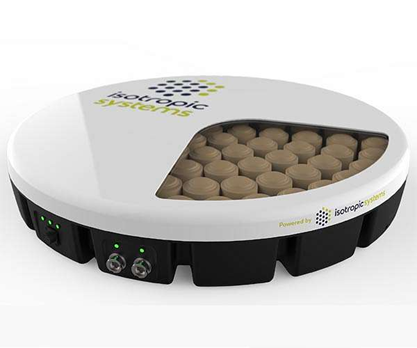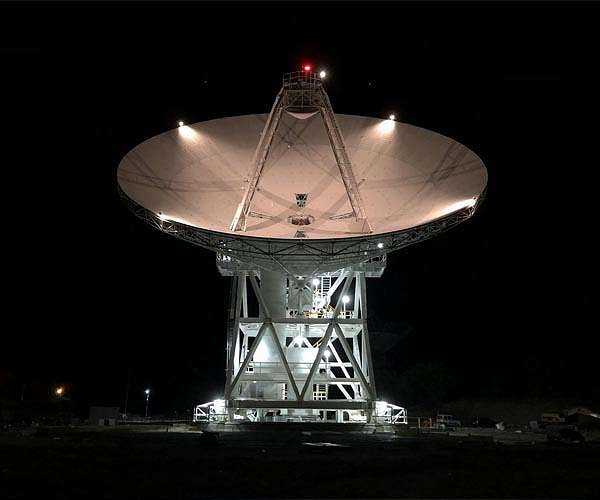TX029 コミュニケーションテクノロジー4 multi-link antenna
Isotropic Systems secures funding to develop multi-link antenna through to product launch in 2022
by Staff Writers
London, UK (SPX) Sep 28, 2021
Isotropic Systems is developing the world’s first multi-service, high-bandwidth, low power, fully integrated range of high throughput terminals designed to support the satellite industry to ‘reach beyond’ traditional markets.

Isotropic Systems, a leading developer of transformational broadband terminal technologies, announces that it has raised over $37 million in an equity financing round, which fully funds the development of its game-changing multi-link antennas through to product launch in 2022.
The round is led by Seraphim Space Investment Trust PLC – the world’s first listed space tech fund – in the first significant investment since its IPO on the London Stock Exchange in July. The round also included participation from leading strategic and deep-tech venture capital investors including AEI HorizonX, Promus Ventures through its Luxembourg based space investment fund Orbital Ventures, and Firmament Ventures.
Concurrently, Isotropic Systems continues to attract significant support from industry-leading strategic investors including SES and the UK Government. The continued support from existing investors was driven by Isotropic Systems’ significant progress into the mature stages of product development, providing accelerated funding to achieve upcoming pivotal milestones and fully fund Isotropic through the commercial launch of its first product line in 2022.
As a result, Isotropic Systems has accelerated its production phase in time to support new constellations and satellites launching in GEO, HEO, MEO and LEO orbits from 2022 onwards, and has expanded its workforce by 40% over the last five months.
Isotropic Systems’ patented radio frequency optics technology enables the high-performance multi-link antenna to simultaneously connect to multiple satellites in multiple orbits without any compromise in the performance of each link. This industry first unlocks the global satellite ecosystem for unprecedented connectivity across a broad range of markets, including government, defence, maritime, enterprise, and aerospace. With multiple new space constellations being launched by organisations including OneWeb, Inmarsat, Intelsat, SpaceX, Amazon, SES and Telesat, innovation in space needs to be matched by innovation on the ground, sea and in the air. Isotropic Systems was recently recognised by its inclusion in Lazard’s T100 Index, reflecting its potential for significant growth and sector disruption.
John Finney, Isotropic Systems Founder and CEO, said: “We are delighted to announce this new funding today, which will bring our game-changing technology to reality within the next 12 months. The strong interest we have received from across the industry has given us the confidence to accelerate our growth plans and bring forward the commercialisation of our groundbreaking new terminals, harnessing the potential of the thousands of new satellites being launched across multiple orbits in the year ahead.
“Seraphim Space Investment Trust is invested in many sector leaders within the space ecosystem that have the potential to dominate globally, several of whom are already valued at more than $1 billion. We are delighted that they have led this fundraising round and look forward to James Bruegger joining our Board.”
James Bruegger, CIO of Seraphim Space (Manager) LLP, Seraphim Space Investment Trust’s investment manager, said: “Isotropic Systems is a prime example of why we looked to list our new fund on the London Stock Exchange. With the Seraphim Space Investment Trust, we now have the financial firepower to double down with conviction on our highest potential investments. With its unparalleled ability to simultaneously connect to satellites in different constellations and different orbits, we believe that Isotropic Systems has the technology that will help unlock massive potential growth within the satellite communications market. We are delighted to be stepping up our support for this exciting business as it enters a critical phase in its development.
“This highlights our commitment to financing the best-of-breed companies we see as potential global leaders in Space Tech whilst offering investors a diversified portfolio of companies in the burgeoning Space Tech sector.”
Brian Schettler, Partner and Head of AEI HorizonX, said: “Isotropic Systems unlocks the industry’s ability to provide connectivity to the wave of next generation high-throughput satellites given Isotropic’s dramatic improvements in terminal capabilities at lower costs. The ability to affordably bring seamless and simultaneous connectivity to these new satellites across multiple orbits with different frequencies will be revolutionary, as well as critical to meet the growing demand for broadband data across the globe. We are pleased that our support will help enable this to become a reality.”
Related Links
Isotropic Systems
Space Technology News – Applications and Research
NASA’s Deep Space Network looks to the future
by Laurance Fauconnet
Pasadena CA (JPL) Sep 02, 2021
DSN dish in Madrid, Spain

When NASA’s Mars 2020 Perseverance rover touched down on the Red Planet, the agency’s Deep Space Network (DSN) was there, enabling the mission to send and receive the data that helped make the event possible. When OSIRIS-REx took samples of asteroid Bennu this past year, the DSN played a crucial role, not just in sending the command sequence to the probe, but also in transmitting its stunning photos back to Earth.
The network has been the backbone of NASA’s deep space communications since 1963, supporting 39 missions regularly, with more than 30 NASA missions in development. The team behind it is now working hard to increase capacity, making a number of improvements to the network that will help advance future space exploration.
Managed by NASA’s Jet Propulsion Laboratory for the Space Communications and Navigation Program, based at NASA Headquarters within the Human Exploration and Operations Mission Directorate, the DSN is what enables missions to track, send commands to, and receive scientific data from faraway spacecraft.
The network consists of tracking antennas across three complexes evenly spaced around the world at the Goldstone complex near Barstow, California; in Madrid, Spain; and in Canberra, Australia. In addition to supporting missions, the antennas are regularly used to conduct radio science – studying planets, black holes, and tracking near-Earth objects.
“Capacity is a big pressure, and our antenna-enhancement program is going to help that out. This includes the building of two new antennas, increasing our number from 12 to 14,” said JPL’s Michael Levesque, deputy director of the DSN.
Network Upgrades
In January 2021, the DSN welcomed its 13th dish to the family. Named Deep Space Station 56 (DSS-56), this new 34-meter-wide (112-foot-wide) dish in Madrid is an “all-in-one” antenna. Previously constructed antennas are limited in the frequency bands they can receive and transmit, often restricting them to communicating with specific spacecraft. DSS-56 was the first to use the DSN’s full range of communication frequencies as soon as it went online and can communicate with all the missions that the DSN supports.
Soon after bringing DSS-56 online, the DSN team completed 11 months of critical upgrades to Deep Space Station 43 (DSS-43), the massive 70-meter (230-foot) antenna in Canberra. DSS-43 is the only dish in the Southern Hemisphere with a transmitter powerful enough, and that broadcasts the right frequency, to send commands to the distant Voyager 2 spacecraft, which is now in interstellar space. With rebuilt transmitters and upgraded facilities equipment, DSS-43 will serve the network for decades to come.
“The refresh of DSS-43 was a huge accomplishment, and we’re on our way to take care of the next two 70-meter antennas in Goldstone and Madrid. And we’ve continued to deliver new antennas to address growing demand – all during COVID-19,” said JPL’s Brad Arnold, manager of the DSN.
The improvements are part of a project to meet not just the heightened demand, but also evolving mission needs.
Missions increasingly generate more data than in the past. The data rate from deep space spacecraft has grown by more than 10 times since the first lunar missions in the 1960s. As NASA looks toward sending humans to Mars, this need for higher data volumes will only increase further.
Optical communications is one tool that can help meet this demand for higher data volumes by using lasers to enable higher-bandwidth communication. Over the next few years, NASA has several missions planned to demonstrate laser communications that will enhance the agency’s ability to explore farther into space.
New Approaches
The network is also focusing on new approaches to how it goes about its work. For instance, for most of the DSN’s history, each complex was operated locally. Now, with a protocol called “Follow the Sun,” each complex takes turns running the entire network during their day shift and then hands off control to the next complex at the end of the day in that region – essentially, a global relay race that takes place every 24 hours.
The resulting cost savings have been fed into antenna enhancements, and the effort has also strengthened the international cooperation between the complexes. “Each site works with the other sites, not just during handover periods, but also on maintenance and how antennas are performing on any given day. We’ve really turned into a globally operating network,” said Levesque. (アンテナのメンテナンス費用を低減する為にSupport resource 分析が必要?)
The network has also implemented new approaches to managing deep space communications. For instance, in the past, if multiple spacecraft circling Mars needed to be serviced at the same time, the network would have to point one antenna per spacecraft at Mars, potentially using all the antennas at a given complex. With a new protocol, the DSN can receive multiple signals from a single antenna and split them in the digital receiver. “We adapted this from commercial telecommunication implementations to the benefit of our network efficiency,” said Arnold.
An additional new protocol allows operators to oversee multiple activities simultaneously. Traditionally, each spacecraft activity had a single dedicated operator. Now, the DSN uses an approach that leverages automation to allow each operator to oversee multiple spacecraft links simultaneously. For the first time, the DSN can now fully automate the sequencing and execution of tracking passes, and the effort will continue to be enhanced over time.
“The future of the DSN is going to follow the spirit and the drive of science missions that are flying out there. It’s our responsibility to enable them. And we do that through communications,” said Arnold.
Related Links
Space Communications and Navigation Program
Space Technology News – Applications and Research
Best regards,
Shoichi Sugiyama, Ph.D.

